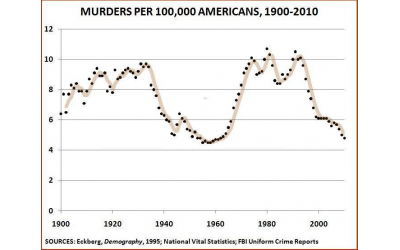Publisher’s Note: Crime Statistics
Michael A. Morris is the owner and publisher of the Atlanta Jewish Times.
My column last week spoke about the United States’ burgeoning population. Apparently, I am not the only person considering the ramifications of our amazingly lenient immigration policy over the last century. Prager University released a video this week called “A Nation of Immigrants” by Michelle Malkin, an author and television host. This five-minute tutorial focuses on current immigration levels, and the impact of our population, and it confirms many of the same numbers and concepts I highlighted in my column.
As I stated last week, population in the U.S. increased from 79 million in 1900 to 327 million in 2018. More specifically, our population grew by 200 million from 1935 until today, in just 83 years. This expansion puts pressure on virtually every segment of our welfare such as education, employment, traffic, living space, healthcare, crime, and the list goes on. Let me specifically target crime statistics.

Crime statistics are typically quoted on a per capita basis, specifically, per 100,000 people. It is also well-documented that a higher density of population, such as urban settings, sustains more crime than lower density areas, such as rural or suburban areas. My perception is that the general news media is suggesting that crime in the U.S. has been growing and even increasing unchecked in recent years. The actual statistics demonstrate that on a per capita basis, even with significant growth in urban America, crime, and specifically murder, has not increased at all. As our population has quadrupled, so has the number of murders as well as the amount of food we consume, cars we own, living space we occupy. However, murder has not increased in 100 years, and in fact, is down on a per capita basis since its peak in the late 70s to early 90s. Murder in the U.S. has fluctuated between five to 10 per 100,000 people over the past 100 years and is hovering at its low, around five to six right now (in 2015, it was just under five; in 2017, it was closer to six).
What this suggests is that, as a society, we unfortunately perpetuate a certain amount of crime (as we do unemployment). Murder, specifically in the U.S., is directly correlated to the size of our population. For the same reason, we can never reduce the unemployment rate to zero; some people will always want to leave their job temporarily. We can never reduce the murder rate to zero; some people will always get into an argument. What has changed in our society is documentation of various crimes, such as murder, and the dissemination and availability of it as news. In 1900, it is unlikely that you would have heard about murders three states away unless the proportion increased dramatically in a short period of time. Today, the internet can tell you exactly how many murders there are in any given city on a daily basis. As an example, about eight people are shot and two of those shot are killed each day in Chicago alone. Of those shot and killed in Chicago, a police officer is responsible for the killing about once a month. Of course these statistics beg the question as to why we only hear about one or two of these killings a year; and, why we interpolate the two killings we hear about to represent the other 650 or so.
The bottom line is, just because we know how to use the internet to learn about the breadth of murders in the U.S. each year, does not mean the number of murders is increasing. Specifically, the murder rate in the U.S. is not outpacing population growth, but population growth is a defining factor in our murder rate.
I use the specific example of crime and murder to demonstrate that as we look at our welfare in America and discuss education, immigration, healthcare, employment, wealth and a multitude of other problems, we must do so through a prism of our population. As I stated in last week’s column: Our unprecedented population growth must be a factor in making rational decisions for our welfare and governance.




comments